Brassica oleracea
| Brassica oleracea | |
|---|---|
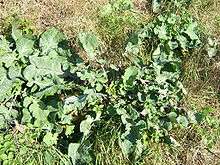 | |
| Wild cabbage plants | |
| Scientific classification | |
| Kingdom: | Plantae |
| (unranked): | Angiosperms |
| (unranked): | Eudicots |
| (unranked): | Rosids |
| Order: | Brassicales |
| Family: | Brassicaceae |
| Genus: | Brassica |
| Species: | B. oleracea |
| Binomial name | |
| Brassica oleracea L. | |
Brassica oleracea is the species of plant that includes many common foods as cultivars, including cabbage, broccoli, cauliflower, kale, Brussels sprouts, collard greens, savoy, kohlrabi and kai-lan.
In its uncultivated form, it is known as wild cabbage. It is native to coastal southern and western Europe. Its high tolerance of salt and lime and its intolerance of competition from other plants typically restrict its natural occurrence to limestone sea cliffs, like the chalk cliffs on both sides of the English Channel,[1] and the windswept coast on the western side of the Isle of Wight.
Wild B. oleracea is a tall biennial plant, forming a stout rosette of large leaves in the first year, the leaves being fleshier and thicker than those of other species of Brassica, adaptations to store water and nutrients in its difficult growing environment. In its second year, the stored nutrients are used to produce a flower spike 1 to 2 metres (3–7 ft) tall bearing numerous yellow flowers.
Cultivation and uses
B. oleracea has become established as an important human food crop plant, used because of its large food reserves, which are stored over the winter in its leaves. It is rich in essential nutrients including vitamin C. A diet rich in cruciferous vegetables (e.g., cabbage, broccoli, cauliflower) is linked to a reduced risk of several human cancers.[2]
Although it is believed to have been cultivated for several thousand years, its history as a domesticated plant is not clear before Greek and Roman times, when it was a well-established garden vegetable. Theophrastus mentions three kinds of rhaphanos (ῤάφανος):[3] a curly-leaved, a smooth-leaved, and a wild-type.[4] He reports the antipathy of the cabbage and the grape vine, for the ancients believed cabbages grown near grapes would impart their flavour to the wine.[5] It has been bred into a wide range of cultivars, including cabbage, broccoli, cauliflower, brussels sprouts, collards, and kale, some of which are hardly recognisable as being members of the same genus, let alone species. The historical genus of Crucifera, meaning "cross-bearing," may be the only unifying feature beyond taste.

Origins
According to the Triangle of U theory, B. oleracea is very closely related to five other species of the genus Brassica.[6]
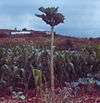
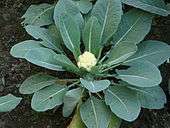
The cultivars of B. oleracea are grouped by developmental form into seven major cultivar groups, of which the Acephala ("non-heading") group remains most like the natural Wild Cabbage in appearance:
- Brassica oleracea Acephala Group – kale and collard greens
- Brassica oleracea Alboglabra Group – Chinese broccoli or Kai-lan
- Brassica oleracea Botrytis Group – cauliflower, Romanesco broccoli and broccoflower
- Brassica oleracea Capitata Group – cabbage
- Brassica oleracea Gemmifera Group – brussels sprouts
- Brassica oleracea Gongylodes Group – kohlrabi
- Brassica oleracea Italica Group – broccoli
In places such as the Channel Islands and Canary Islands where the frost is minimal and plants are thus freed from seasonality, some cultivars, known as Jersey cabbages, can grow up to three meters tall. These "tree cabbages" yield fresh leaves throughout the year, are perennial, and do not need to be destroyed at harvest as with a normal cabbage. Their woody stalks are sometimes dried and made into walking sticks.[7]
History

With the advent of agriculture and the domestication of wild crop plants, the peoples of the Mediterranean began cultivating wild cabbage. Through artificial selection for various phenotype traits the emergence of variations of the plant with drastic differences in looks took only a few thousand years. Preference for leaves, terminal bud, lateral bud, stem and inflorescence evolved the wild cabbage into the many forms we know today.[8]
Impact of Preference[9]
- The preference for the eating of the leaves led to the selection of plants with larger leaves being harvested and their seeds planted for the next growth. Around the 5th century BC the formation of what we now know as kale had developed.
- Preference led to further artificial selection of kale plants with more tightly bunched leaves, or terminal bud. Somewhere around the 1st century AD emerged the phenotype variation of Brassica oleracea that we know as cabbage.
- Phenotype selection preferences in Germany led kale down another evolutionary pathway. By selecting for fatter stems the variant plant known as kohlrabi emerged around the 1st century AD.
- Further selection in Belgium in lateral bud led to the Brussels sprout in the 18th century.
- European preference emerged for eating immature buds, selection for inflorescence. By the 15th century AD cauliflower had developed leading also to the emergence of broccoli in Italy about 100 years later.
Cultivars
| Cultivar | Image | Name |
|---|---|---|
| Wild cabbage |  | Brassica oleracea var. oleracea |
| Cabbage |  | Brassica oleracea var. capitata f, alba |
| Savoy cabbage |  | Brassica oleracea var. capitata f, sabauda |
| Red cabbage |  | Brassica oleracea var. capitata f, rubra |
| Cone cabbage |  | Brassica oleracea var. capitata f, acuta |
| Kai-lan | 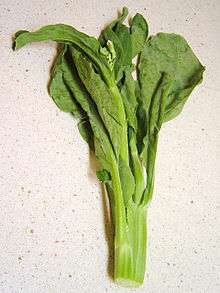 | Brassica oleracea var. alboglabra |
| Collard greens | 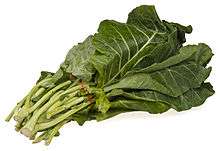 | Brassica oleracea var. viridis |
| Jersey cabbage |  | Brassica oleracea var. longata |
| Ornamental Kale |  | Brassica oleracea var. acephala |
| Kale |  | Brassica oleracea var. sabellica |
| Lacinato kale |  | Brassica oleracea var. palmifolia |
| Perpetual kale | Brassica oleracea var. ramosa | |
| Marrow cabbage |  | Brassica oleracea var. medullosa |
| Tronchuda kale | Brassica oleracea var. costata | |
| Brussels sprout |  | Brassica oleracea var. gemmifera |
| Kohlrabi |  | Brassica oleracea var. gongylodes |
| Broccoli |  | Brassica oleracea var. italica |
| Cauliflower |  | Brassica oleracea var. botrytis |
| Romanesco broccoli |  | Brassica oleracea var. botrytis |
| Broccoli di Torbole | 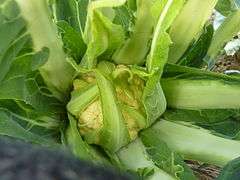 | Brassica oleracea var. botrytis |
| Broccolini | 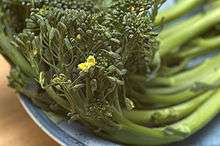 | Brassica oleracea var. italica × alboglabra |
References
- ↑ Snogerup, S., Gustafsson, M., & Von Bothmer, R. (1990). Brassica sect. Brassica (Brassicaceae) I. Taxonomy and variation. Willdenowia, 271-365.
- ↑ Verhoeven DT, Goldbohm RA, van Poppel G, Verhagen H, van den Brandt PA (1996)Epidemiological studies on brassica vegetables and cancer risk.Cancer Epidemiol Biomarkers Prev5(9):733–748.
Higdon JV, Delage B, Williams DE, Dashwood RH (2007) Cruciferous vegetables and human cancer risk: Epidemiologic evidence and mechanistic basis. Pharmacol Res 55(3):224–236. - ↑ Compare Theophrastus; raphanis (ραφανίς), "radish", also a Brassica.
- ↑ Daniel Zohary and Maria Hopf, Domestication of plants in the Old World, third edition (Oxford: Oxford University Press, 2000), p. 199.
- ↑ Theophrastus, Enquiry into Plants, IV.6.16; Deipnosophistae, I, noting the effects of cabbages on wine and wine-drinkers, also quotes Apollodorus of Carystus: "If they think that our calling it a rhaphanos, while you foreigners call it a krambê, makes any difference to us women!" (on-line English text).
- ↑ Dixon, G.R. (2007), Vegetable brassicas and related crucifers, Wallingford: CABI, ISBN 978-0-85199-395-9
- ↑ Williams, Paul H.; Hill, Curtis B. (June 13, 1986), "Rapid-Cycling Populations of Brassica" (pdf), Science, New Series, American Association for the Advancement of Science, 232 (4756): 1385–1389, doi:10.1126/science.232.4756.1385, PMID 17828914
- ↑ Osnas, Jeanne L. D. "The extraordinary diversity of Brassica oleracea". The Botanist in the Kitchen. Retrieved 2016-04-07.
- ↑ "Vegetables - University of Saskatchewan". agbio.usask.ca. Retrieved 2016-04-07.
External links
| Wikimedia Commons has media related to Brassica oleracea. |
- PROTAbase on Brassica oleracea (Brussels sprouts)
- PROTAbase on Brassica oleracea (cauliflower and broccoli)
- Video Overview of Brassica oleracea: from Untamed Science
